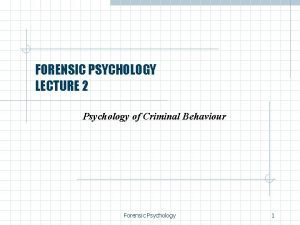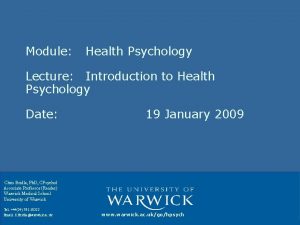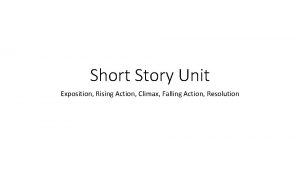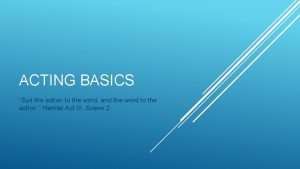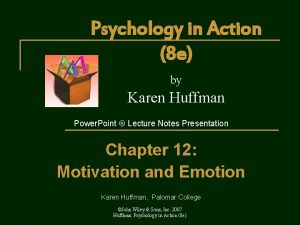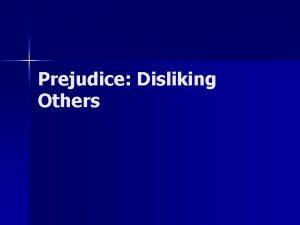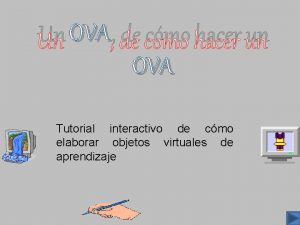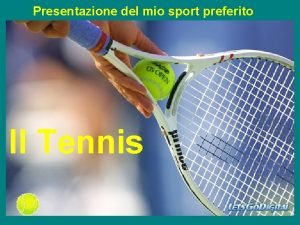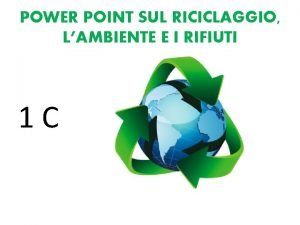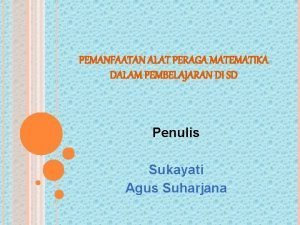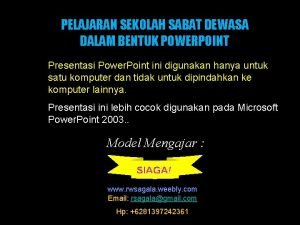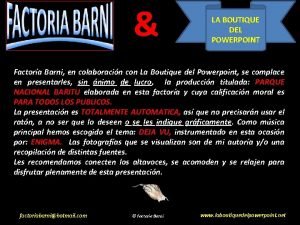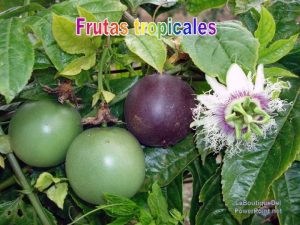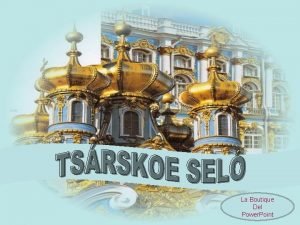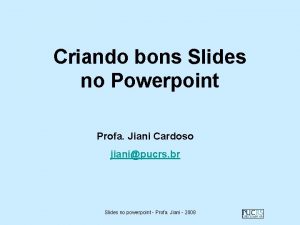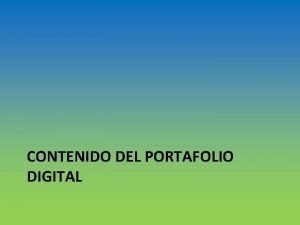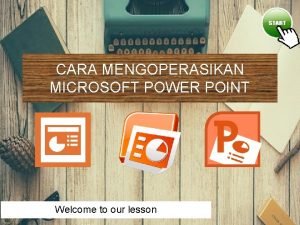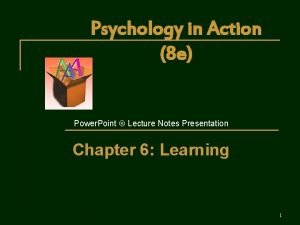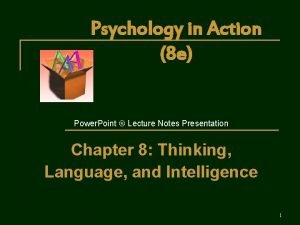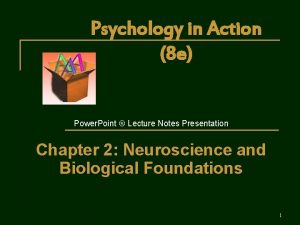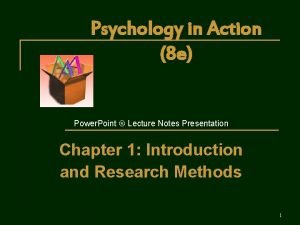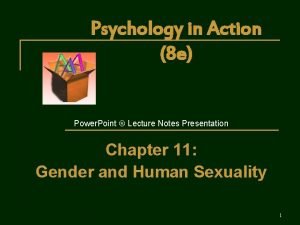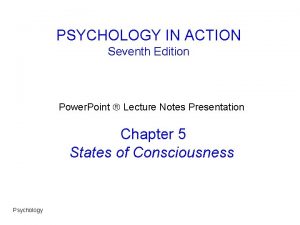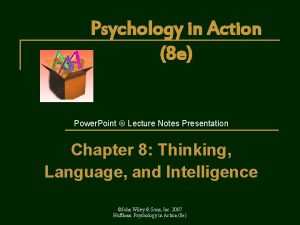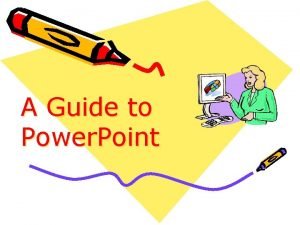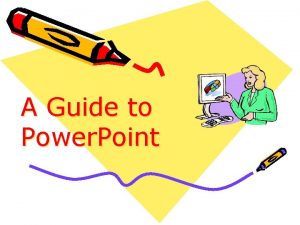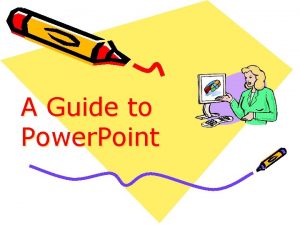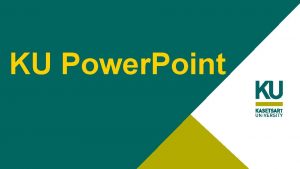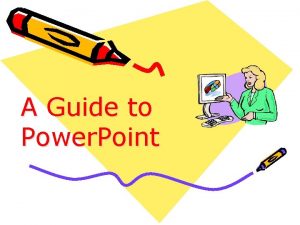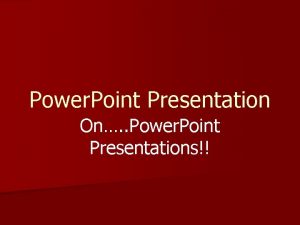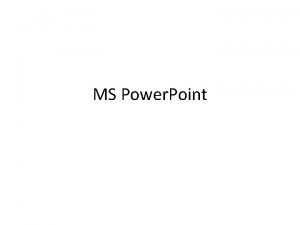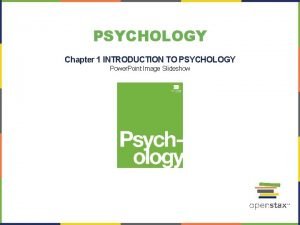Psychology in Action 8 e Power Point Lecture



















































- Slides: 51

Psychology in Action (8 e) Power. Point Lecture Notes Presentation Chapter 3: Stress and Health Psychology 1

Lecture Overview n Understanding Stress n Stress and Illness n Health Psychology in Action n Health and Stress Management 2

Understanding Stress n What is Stress? – A nonspecific response of the body to any demand made on it; – the arousal, both physical and mental, to situations or events that we perceive as threatening or challenging. 3

Understanding Stress: Sources of Stress 4

Understanding Stress: Sources of Stress (Continued) n Cataclysmic Events: stressors that occur suddenly and generally affect many people simultaneously 5

Understanding Stress: Sources of Stress (Continued) n Chronic Stressors: ongoing, long lasting, unpleasant events 6

Understanding Stress: Sources of Stress (Continued) n Life Changes: life events that require some adjustment in behavior or lifestyle 7

Understanding Stress: Sources of Stress (Continued) 8

Understanding Stress: Sources of Stress (Continued) n Hassles: : small, everyday problems that accumulate to become source of stress 9

Understanding Stress: Sources of Stress (Continued) n Occupation Burnout: state of psychological and physical exhaustion resulting from chronic exposure to high levels of stress and little personal control 10

Understanding Stress: Sources of Stress (Continued) Frustration unpleasant tension resulting from a blocked goal Conflict forced choice between two or more incompatible goals or impulses 11

Understanding Stress: Sources of Stress (Continued) § Three Types of Conflict • Approach-Approach: forced choice between two or more desirable alternatives • Avoidance-Avoidance: forced choice between two or more undesirable alternatives • Approach-Avoidance: forced choice between two or more alternatives both having desirable and undesirable results 12

Understanding Stress: Sources of Stress (Continued) § If this man is interested in one of the three women on the couch, is he experiencing an approach-approach, approach-avoidance, or avoidance conflict? 13

Stress and Illness n Walter Cannon observed that, in response to stress, the sympathetic nervous system activates the secretion of stress hormones, triggers increased heart rate and respiration, diverts blood to skeletal muscles, and releases sugar and fat from the body’s stores, all to prepare the body for either “fight or flight. ”

Figure 14. 2 Stress appraisal Myers: Psychology, Eighth Edition Copyright © 2007 by Worth Publishers

Figure 14. 3 Two-track stress response system Myers: Psychology, Eighth Edition Copyright © 2007 by Worth Publishers

Stress and Illness n. In addition to this first (and faster) track (fight or flight), the cerebral cortex operates on a slower track by stimulating the hypothalamus and the pituitary gland to trigger the release of glucocorticoid stress hormones, such as cortisol, from the outer part of the adrenals.

Understanding Stress: Effects of Stress Sympathetic Nervous System HPA Axis 18

Understanding Stress: Effects of Stress (Continued) n Stress and the HPA Axis: n Prolonged elevation of cortisol is related to: q increased depression, memory problems, etc. q impaired immune system, which leaves the body vulnerable to disease. 19

Understanding Stress: Effects of Stress (Continued) n Stress and the Immune System n Psychoneuroimmunology: interdisciplinary field that studies the effect of psychological factors on the immune system 20

Understanding Stress: Effects of Stress (Continued) n Selye’s General Adaptation Syndrome 1. Alarm 2. Resistance 3. Exhaustion 21

Stress and Illness n. In addition to this first (and faster) track (fight or flight), the cerebral cortex operates on a slower track by stimulating the hypothalamus and the pituitary gland to trigger the release of glucocorticoid stress hormones, such as cortisol, from the outer part of the adrenals.

Stress n. In Hans Selye’s general adaptation syndrome (GAS), the body’s adaptive response to stress is composed of three stages. n. In Phase 1, we experience an alarm reaction due to the sudden activation of our sympathetic nervous system. Heart rate increases and blood is diverted to the skeletal muscles.

Figure 14. 4 Selye’s general adaptation syndrome Myers: Psychology, Eighth Edition Copyright © 2007 by Worth Publishers

Stress n With our resources mobilized, we then fight the challenge during Phase 2, resistance. n Temperature, blood pressure, and respiration remain high, and there is a sudden outpouring of stress hormones. If the stress is persistent, it may eventually deplete our body’s reserves during Phase 3, exhaustion. n With exhaustion, we are more vulnerable to illness or even, in extreme cases, collapse and death.

Extreme Stress n. Catastrophic floods, hurricanes, and fires are followed by increased rates of psychological disorders such as depression and anxiety. n. Those who experience significant life changes, such as the death of a spouse, divorce, or loss of a job, are vulnerable to disease. Experiencing a cluster of such crises puts one even more at risk.

Extreme Stress n. Daily hassles, such as rush-hour traffic, long lines at the bank or store, and aggravating housemates, may be the most significant source of stress. n. Over time, these little stressors take a toll on our health and well-being.

Extreme Stress n Stress can increase the risk of coronary heart disease, the leading cause of death in many developed countries. n It has been linked with the competitive, hard-driving, and impatient Type A personality. n The toxic core of Type A is negative emotions, especially the anger associated with an aggressively reactive temperament.

Extreme Stress n Under stress, the body of the Type A person secretes more of the hormones that accelerate the buildup of plaques on the heart’s artery walls (epinephrin, norepinephrin, cortisol) n The noncompetitive, relaxed, easy-going Type B personality is less physiologically reactive when harassed or given a difficult challenge and less susceptible to coronary heart disease. n Pessimism and depression also can have a toxic effect on a person’s health.

Psychophysiological Illness and Hypochondriasis n. Psychophysiological illness refers to any stress-related physical illnesses such as hypertension and some headaches. n. These real illnesses differ from hypochondriasis, in which people may misinterpret normal physical sensations as symptoms of a disease

Stress & the Immune System n The secretion of stress hormones suppresses the immune system’s white blood cells, called lymphocytes. n B lymphocytes are important in fighting bacterial infections, and T lymphocytes fight cancer cells, viruses, and foreign substances. n Another agent of the immune system is the macrophage.

Stress & the Immune System n. When animals are physically restrained, given unavoidable electric shocks, or subjected to noise, crowding, cold water, social defeat, or maternal separation, they become more susceptible to disease. n. Studies suggest that stress similarly depresses the human immune system, making us more vulnerable

Figure 14. 10 Stress can have a variety of health-related consequences Myers: Psychology, Eighth Edition Copyright © 2007 by Worth Publishers

Stress and Illness Cancer: related to hereditary disposition and environmental factors Cardiovascular Disorders: contributing factors include stress hormones, certain personality types, and certain behaviors Posttraumatic Stress Disorder (PTSD): anxiety disorder following exposure to extraordinary stress Gastric Ulcers: caused by bacteria or stress? 34

Stress and Illness (Continued) 35

Health Psychology in Action n Health Psychology: studies how biological, psychological, and social factors affect health and illness n Major Health Risks: 1. Tobacco 2. Alcohol and Binge Drinking 3. Chronic Pain (lasting over 6 months) 36

Health Psychology in Action (Continued) n Does this graph surprise you? Smokers often overestimate their risk of dying from homicide and traffic accidents, and greatly underestimate the risk from smoking. 37

Health and Stress Management n Two major approaches to coping stress: with emotion-focused (changing one's perception of stressful situations) 2. problem-focused (using problemsolving strategies to decrease or eliminate the source of stress) 1. 38

Health and Stress Management (Continued) n Our emotional reaction to stress largely depends on how we interpret it. 39

Style, Stress, & Health n. In comparison to pessimists, optimists report less fatigue, have fewer aches and pains, and respond to stress with smaller increases in blood pressure. n. Optimists also tend to outlive pessimists. Laughter (but not hostile sarcasm) may reduce stress and strengthen the immune

Social Support & Stress n. Feeling liked, affirmed, and encouraged by intimate friends and family promotes both happiness and health. n. People with supportive friends and marriage partners eat better, exercise more, sleep better, and smoke less; thus they cope with stress more effectively.

Social Support & Stress n. Social support strengthens immune functioning, calms the cardiovascular system, and lowers blood pressure. n. Even companionable pets help people cope with stressful events.

Aerobic Exercise & Stress n. Aerobic exercise, sustained exercise that increases heart and lung fitness, can reduce stress, depression, and anxiety. n. It strengthens the heart, increases blood flow, keeps blood vessels open, and lowers both blood pressure and the blood pressure reaction to stress.

Aerobic Exercise & Stress n. Research has linked aerobic exercise to higher levels of neurotransmitters that boost moods, to enhanced cognitive abilities, and to the growth of new brain cells in mice. n. One estimate suggests that moderate exercise adds two years to one’s expected life.

Figure 14. 13 Aerobic exercise and depression Myers: Psychology, Eighth Edition Copyright © 2007 by Worth Publishers

Biofeedback and Relaxation Training n Alternative medicine may seem especially effective with cyclical diseases as people seek therapy during the downturn and presume its effectiveness during the ensuing upturn. n The placebo effect as well as the spontaneous remission of many diseases may also contribute to a treatment’s perceived effectiveness. n The actual effectiveness of alternative medicine needs to be established.

Religiosity and Longevity n Research indicates that those who attend religious services regularly live as many as 8 years longer than nonattenders. n Investigators who attempt to explain the relationship have isolated three intervening variables. n (1) Religiously active people have healthier life-styles, for example, they smoke and drink less.

Religiosity and Longevity n (2) Faith communities provide social support networks and often encourage marriage which, when happy, is linked with better health and a longer life span. n (3) Religious attendance is often accompanied by a coherent worldview, sense of hope for the future, feelings of acceptance, and a relaxed meditative state. n These may enhance feelings of positive emotions and decrease feelings of stress and anxiety.

Figure 14. 18 Possible explanations for the correlation between religious involvement and health/longevity Myers: Psychology, Eighth Edition Copyright © 2007 by Worth Publishers

Biofeedback and Relaxation Training n Biofeedback, a system of recording, amplifying, and feeding back information about subtle physiological responses, enables people to control specific physiological responses. n Research suggests that biofeedback works best on tension headaches. n Simpler methods of relaxation produce many of the technique’s same benefits.

Health and Stress Management (Continued)n Resources for Healthy Living 1. 2. 3. 4. 5. 6. Health and Exercise Positive Beliefs Social Skills Social Support Material Resources Control (Internal locus of control) 7. Relaxation 51
 01:640:244 lecture notes - lecture 15: plat, idah, farad
01:640:244 lecture notes - lecture 15: plat, idah, farad Power triangle
Power triangle Power bi training powerpoint
Power bi training powerpoint Point point power
Point point power Social psychology lecture
Social psychology lecture Forensic psychology lecture
Forensic psychology lecture Introduction to psychology lecture
Introduction to psychology lecture Definition of health psychology
Definition of health psychology Power system dynamics and stability lecture notes
Power system dynamics and stability lecture notes Zline 667-36
Zline 667-36 Power semiconductor devices lecture notes
Power semiconductor devices lecture notes Switch mode power supply lecture notes
Switch mode power supply lecture notes Power system dynamics and stability lecture notes
Power system dynamics and stability lecture notes What are some traditions in things fall apart
What are some traditions in things fall apart Flash forward plot structure
Flash forward plot structure Wizard of oz plot diagram
Wizard of oz plot diagram Story mountain exposition
Story mountain exposition Exposition in a rose for emily
Exposition in a rose for emily Suit the action to the word the word to the action meaning
Suit the action to the word the word to the action meaning Extrinsic rewards
Extrinsic rewards Positive psychology ap psychology definition
Positive psychology ap psychology definition Social trap psychology definition
Social trap psychology definition Social psychology ap psychology
Social psychology ap psychology History and origin of science of psychology slideshare
History and origin of science of psychology slideshare Social psychology is the scientific study of:
Social psychology is the scientific study of: Health psychology definition ap psychology
Health psychology definition ap psychology Nature and power of prejudice
Nature and power of prejudice Solar power satellites and microwave power transmission
Solar power satellites and microwave power transmission Actual power and potential power
Actual power and potential power Flex power power supply
Flex power power supply What is dispersive power of grating
What is dispersive power of grating Power of a power property
Power of a power property General power rule
General power rule Power angle curve in power system stability
Power angle curve in power system stability Power absorbed or supplied
Power absorbed or supplied Evangelio del domingo en power point
Evangelio del domingo en power point Ejemplos de ova en power point
Ejemplos de ova en power point La boutique del powerpoint
La boutique del powerpoint Storia del tennis tesina
Storia del tennis tesina Tm pp
Tm pp Power point sul riciclo in inglese
Power point sul riciclo in inglese Blok dienes
Blok dienes Slideshow sekolah sabat
Slideshow sekolah sabat Barni
Barni La boutique del power point
La boutique del power point La boutique del power point
La boutique del power point La boutique del powerpointx
La boutique del powerpointx Gizi kuliner adalah
Gizi kuliner adalah Decreto 1330 del 25 de julio de 2019
Decreto 1330 del 25 de julio de 2019 Conclusão apresentação power point
Conclusão apresentação power point Contenido de un portafolio
Contenido de un portafolio Icon pada toolbar untuk format penomoran adalah…….
Icon pada toolbar untuk format penomoran adalah…….





